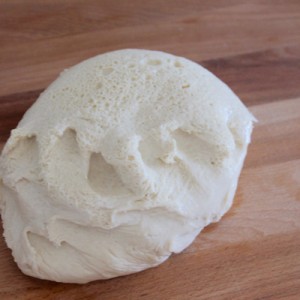NYC BAGEL
There are so many recipes of bagel and all of them decalre it is the ‘original’ one.
Even though the ‘original’ one would taste like something we would never appreciated today (as if we were tasting cheese made exactly as they made it 100 years ago!).
So I got rid of the originality and reading and researching I made my own version. The result is great: a soft but firm bagel, very good and even better when toasted.
Everything is in the proofing process. The consistency of a bagel is due to the boiling part. Boil the dough stresses and shocks the proofing process creating this world famous breakfast treat.
A few rules for a perfect result:
1) contrarily to any bread the bagel dough should be compact, sticky but not too much (after kneading the dough should detach from your hands easily);
2) The first proofingshould be as long as need to have a dough which has grown 3 times its original size (1 hour in summer, maybe 2 hours in winter). The trick is: Summer: 30 minutes outside; 1 hour refrigerated; Winter: 1 hour and a half outside; 1 hours refrigerated.
The refrigeration reduces the proofing intensity. Out of the fridge you can make the bagels.
3) the second proofing (when the bagel are already in shape) should be interrupted as soon as the yeast activates again (10/15 minutes in summer to 30 minutes in winter), at sight they will look bigger and at touch they will feel soft.
Out of the fridge, punch the dough and knead gently just to pull the extra air out.
Roll the dough into 10cm diameter balls and make a hole in the center with your hand
4) boiling is a shock to the yeast and it reduces dramatically the proofing. The water should be salted and boiling hot, add a teaspoon of soda bicarbonate (it helps in making them darker).
It has to be boiled upside down onto the water for 30 seconds, and 30 seconds on the other side. Put on a clith to absorb exceeding water. Bagels should not be boiled for more than 30/40 seconds per side – this will allow the hart of it to have stilla live dough capable of proofing when baking in the oven.
500 grams strong flour
250-300 ml lukewarm water
1 tsp salt
7 grams dried yeast
1 tbs malt syrup (if available)
2 tsp granulated sugar
To boil:
water
2 tbs salt
1 tbs soda bicarbonate
In half glass of warm water, put the dried yeast (do not mix, let it stand on the surface), and set aside for 10 minutes.
In a container instead, put the flour and all the dry ingredients, add the melted yeast and mix with a fork first and with your hands later. Add as much water as needed to have a soft but consistent dough. Knead for 10 minutes at least.
Set aside and allow the first proofing (part outside and part inside the fridge) unitil it triplicates its original volume – you should follow the below instructions:
Summer (temperature above 25° C) > 2H15 (1H15 outside fridge; 1H into the fridge)
Winter (temperature below 22° C) > 3H30 (2H/2H30 outside fridge; 1H into the fridge)
When triplicate, punch the dough and knead for a couple of minutes.
Divide the mixture into 12 portions (it should be 85 grams each). Make a ball out of each and with a pressure of the thumb and the index make a hole and enlarge it up to 3 centimeters.
Put the bagels on a dripping pan covered with parchment paper and allow second proofing for further:
Summer > 20/25 mins
Winter > 40/45 mins
After this timing, pre-heat the oven to 210° C.
Meanwhile bring water to a boil and add the salt and bicarbonate.
With a kicthen shovel, take gently the bagels and put them into the boiling water (upside down), let cook for 30/40 seconds, turn it and cook for further 30/40 seconds. Drain with a slotted spoon and put on a cloth to absorb the exceeding water.
Put again on the parchment paper and bake for 12/13 minutes or until golden.
















